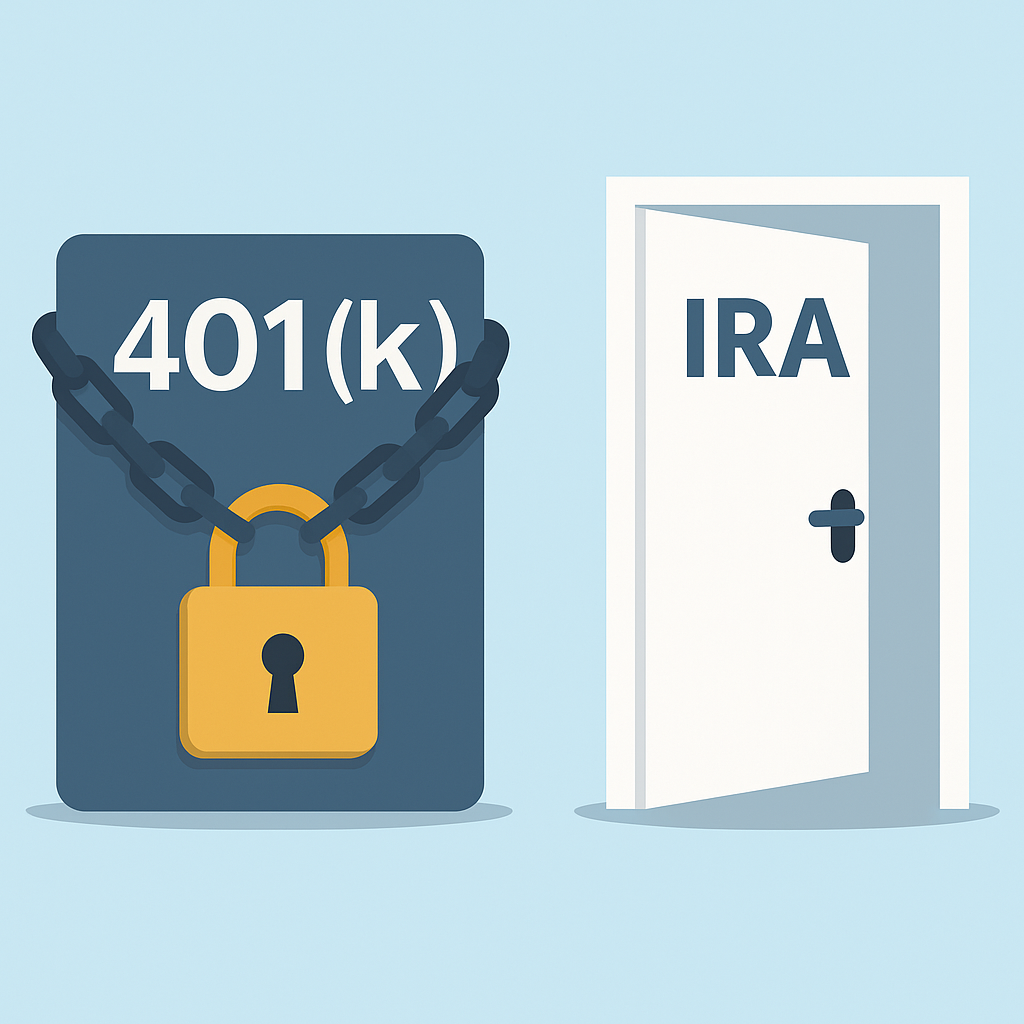Self-Directed 401(k) Trading: Understanding Your Options and Limitations
Self-Directed 401(k) Trading: Understanding Your Options and Limitations

As market volatility creates new sector-specific opportunities and policy changes reshape entire industries, many investors find themselves frustrated by the limited investment options in their employer-sponsored 401(k) plans and wonder whether they can take direct control of their retirement investments to capitalize on emerging trends. The reality is that most traditional 401(k) plans severely restrict participant choices. They typically offer only 10-25 pre-selected mutual funds and target-date funds chosen by employers for administrative convenience rather than performance potential, effectively preventing access to stocks, sector-specific ETFs, or leveraged funds like Direxion that active traders could use for tactical positioning.
Before pursuing self-directed 401(k) trading, investors must understand the availability of these options within their specific plans, carefully analyze the fee structures that can erode returns, and honestly assess whether their trading skills and account sizes justify the additional complexity and costs, especially when alternative account structures like Roth IRAs and taxable brokerage accounts often provide superior flexibility for active investment strategies without the constraints and expenses inherent in employer-sponsored retirement plans.
The Hidden Cost Burden of Self-Directed 401(k) Trading
While approximately 70% of large employers do offer “brokerage windows” or Self-Directed Brokerage Accounts (SDBAs) that expand investment universes to include thousands of individual securities and ETFs, these options come with significant cost considerations, behavioral risks, and regulatory limitations that make them unsuitable for many retirement savers.
The most significant obstacle to successful self-directed 401(k) investing is the substantial fee structure that creates a high performance hurdle most traders cannot consistently clear. Self-directed brokerage accounts typically impose transaction costs of $25-50 per trade, annual maintenance fees ranging from $25-100, and often require participants to accept retail share classes of mutual funds rather than the institutional versions available in core plan lineups (resulting in expense ratio increases of 0.20-0.75% annually on fund holdings).
These seemingly modest fees compound into significant performance drags that demand substantial outperformance just to break even. For example, an investor with a $30,000 account paying $300 annually in combined fees needs to generate 1% additional return above their core plan options merely to justify the costs, while more active traders executing monthly transactions might face fee burdens exceeding 2-3% annually. The mathematical reality becomes even more challenging for smaller account balances, where a $50 trading commission on a $1,000 position represents a devastating 5% immediate cost that requires extraordinary gains to overcome, making self-directed options economically unviable for accounts under $50,000.
This fee structure explains why the vast majority of successful self-directed 401(k) participants limit their active trading to a small portion of their overall allocation, typically 10-20%, while maintaining their core retirement savings in low-cost index funds that benefit from institutional pricing and eliminate transaction costs.

Why Leveraged ETFs Don’t Belong in Retirement Accounts
Leveraged ETFs like Direxion’s 3x products represent a fundamental mismatch with retirement account objectives, as these instruments are engineered for short-term tactical trading over days or weeks rather than the buy-and-hold strategies appropriate for long-term wealth building. The daily rebalancing mechanism that maintains target leverage ratios creates volatility decay that systematically erodes returns during extended holding periods, particularly in choppy markets where the underlying index moves up and down without clear directional trends—a mathematical quirk that can cause leveraged ETFs to lose money even when the underlying index rises over time.
Additionally, retirement accounts eliminate the key advantage that makes leveraged products viable in active trading strategies: the ability to harvest tax losses and frequently rebalance positions to manage risk, leaving investors exposed to amplified volatility without the tactical flexibility needed to manage these complex instruments effectively. For investors seeking leveraged exposure to specific sectors or market movements, these products work far better in taxable brokerage accounts where active management, tax-loss harvesting, and quick position adjustments can help mitigate the inherent risks while capturing intended short-term directional moves.
Superior Account Structures for Active Investment Strategies
Rather than struggling with the limitations and costs of self-directed 401(k) options, active traders have access to more flexible and cost-effective account structures that better serve dynamic investment strategies. Roth IRAs offer the ideal combination of tax advantages and investment freedom, allowing annual contributions of $7,000-8,000 (2025 limits) with complete flexibility to trade individual stocks, sector ETFs, and specialized products like leveraged funds, while providing tax-free growth and no required minimum distributions that could force unwanted position liquidations.
Taxable brokerage accounts deliver ultimate flexibility with unrestricted access to all investment types, the ability to harvest tax losses to offset gains, immediate liquidity without penalties, and commission-free trading at most major brokers, which eliminates the transaction cost barriers plaguing 401(k) brokerage windows. Additionally, investors can maximize their self-directed capabilities by rolling old employer 401(k) plans into traditional or Roth IRAs, accessing the same broad investment universe as taxable accounts while maintaining tax-deferred or tax-free growth, typically with significantly lower fees than employer plan brokerage options and without the restrictive investment menus that limit strategic flexibility.
A Conservative Approach to Self-Directed Trading

For investors determined to pursue self-directed trading within their 401(k) despite the cost and complexity challenges, success requires a disciplined approach that treats the brokerage window as a tactical allocation tool rather than a complete portfolio management solution. Limit self-directed investments to a maximum of 10-20% of your total 401(k) balance, maintaining the remaining 80-90% in low-cost index funds or target-date funds that provide broad market exposure with institutional-class expense ratios and no transaction costs.
Use the brokerage window strategically for specific high-conviction opportunities—such as sector plays in education, infrastructure, or emerging technologies—rather than attempting to actively manage your entire retirement portfolio, which would expose you to unnecessary fees and concentration risk. This core-satellite approach allows you to pursue tactical opportunities while preserving the fundamental retirement planning principle of broad diversification, ensuring that even if your self-directed positions underperform or incur significant costs, the majority of your retirement savings remains positioned for steady, long-term growth through proven low-cost indexing strategies.
Self-Directed Success
Before committing to self-directed 401(k) trading, investors must conduct an honest cost-benefit analysis that calculates the performance hurdle created by additional fees and compares it against their demonstrated trading track record. For example, an investor paying $300 annually in extra fees on a $30,000 account faces an immediate 1% performance deficit that requires consistent outperformance just to break even with low-cost index fund alternatives.
Rather than relying on optimism or recent market successes, potential self-directed traders should honestly evaluate their historical performance, accounting for all costs and opportunity costs, and consider whether their documented ability to generate alpha justifies abandoning the proven wealth-building approach of low-cost, diversified index investing that has reliably served retirement savers for decades.
Despite the allure of taking control and the excitement of pursuing market opportunities, the overwhelming evidence supports a simple truth: the vast majority of 401(k) participants achieve superior long-term results by embracing simplicity rather than complexity in their retirement investing approach. Low-cost target-date funds or straightforward three-fund portfolios combining total stock market, international, and bond index funds provide broad diversification, automatic rebalancing, institutional-class expense ratios, and the behavioral advantage of removing emotional decision-making from the investment process—benefits that consistently outweigh the advantages of self-directed trading for most investors.
Self-directed 401(k) investing should be reserved for the small subset of participants who meet three critical criteria: substantial account balances that can absorb fee impacts, extensive trading experience with documented success in generating alpha, and a thorough understanding of the costs and limitations inherent in employer-sponsored brokerage windows. For everyone else, the path to retirement security lies not in attempting to outsmart the market through active trading, but in harnessing the proven power of low-cost, diversified investing combined with consistent contributions and the discipline to stay the course through market volatility. In retirement planning, boring often beats brilliant, and the investors who resist the temptation to complicate their approach typically enjoy both better returns and better sleep. Set yourself up for success with any retirement plan at Trade Ideas today.
